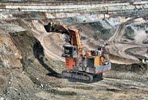The Iron Ore Mining data model set is an integrated set of Enterprise, Business Area, and Data Warehouse data models developed to support the mining, processing and transport operations of iron ore production companies.
Iron ores are rocks and minerals from which metallic iron can be extracted economically. Iron, which is commonly found worldwide, is the world's most commonly used metal and the key ingredient of steel, which represents almost 95% of all iron ore use.
Iron ore mining methods vary by the type of iron ore being mined. There are four primary types of iron ore deposits, which depend upon the mineralogy and geology of the ore deposits.
- Magnetite
- Titanomagnetite
- Massive hematite
- Pisolitic ironstone
Mining iron ore is a high volume low margin business, as the value of iron is significantly lower than other base metals. Consequently, the primary determining factor in the utilization of iron ore deposits is not necessarily the size of the deposit but rather the proximity to the market for the ore, the availability of transportation infrastructure to the market, and the associated costs. Because of the low margins, iron ore miners often exploit opportunities to highly automate their operations, both to increase volumes and to reduce requirements for human resources who can be expensive in the remote locations where iron ore bodies are often located. This has resulted in some cases in adoption of technologies such as remotely monitored driverless trucks and trains.
World production averages about two billion metric tons of raw iron ore annually and is concentrated in the hands of a relatively small number of companies. However, the market for iron ore is changing. Iron ore prices in the past were decided by a small number of miners and steelmakers via benchmarks that were followed by the rest of the industry via benchmark pricing.
Recently that benchmark pricing system has begun to break down and is being replaced by short-term pricing consistent with mature market-based pricing systems for other commodities. A number of financial exchanges (such as the DME Group, Singapore Exchange, Indian Commodities Exchange) and clearing houses are now offering iron ore swaps. In 2014, over 15,000 lots were cleared by the CME Group via options and the Singapore Mercantile Exchange launched the worlds first global iron ore future contract based on the Metal Bulletin Iron Ore Index (MBIOI).
ADRM's Iron Ore Mining data model set provides a data architecture for the integration of planning and operational data with support for, among other things:
| Budgets | Human Resources & Payroll |
| Contracts & Orders | Mine (Activities) |
| Financial Reporting | Iron Ore Processing / Smelting |
| Geography | Mining Property |
| Business Metrics | Property & Equipment |
| Inventory | Purchasing |
| Log Testing | Transportation |
For iron ore mining organizations interested in integrating trading and hedging information into their overall information infrastructure, ADRM already supports such commodity and derivative trading information in its Corporate Investment Banking models and the relevant components of that set of models can be integrated with the Iron Ore Mining data model set when required.
Copyright ©
ADRM Software, Inc.
All Rights Reserved



